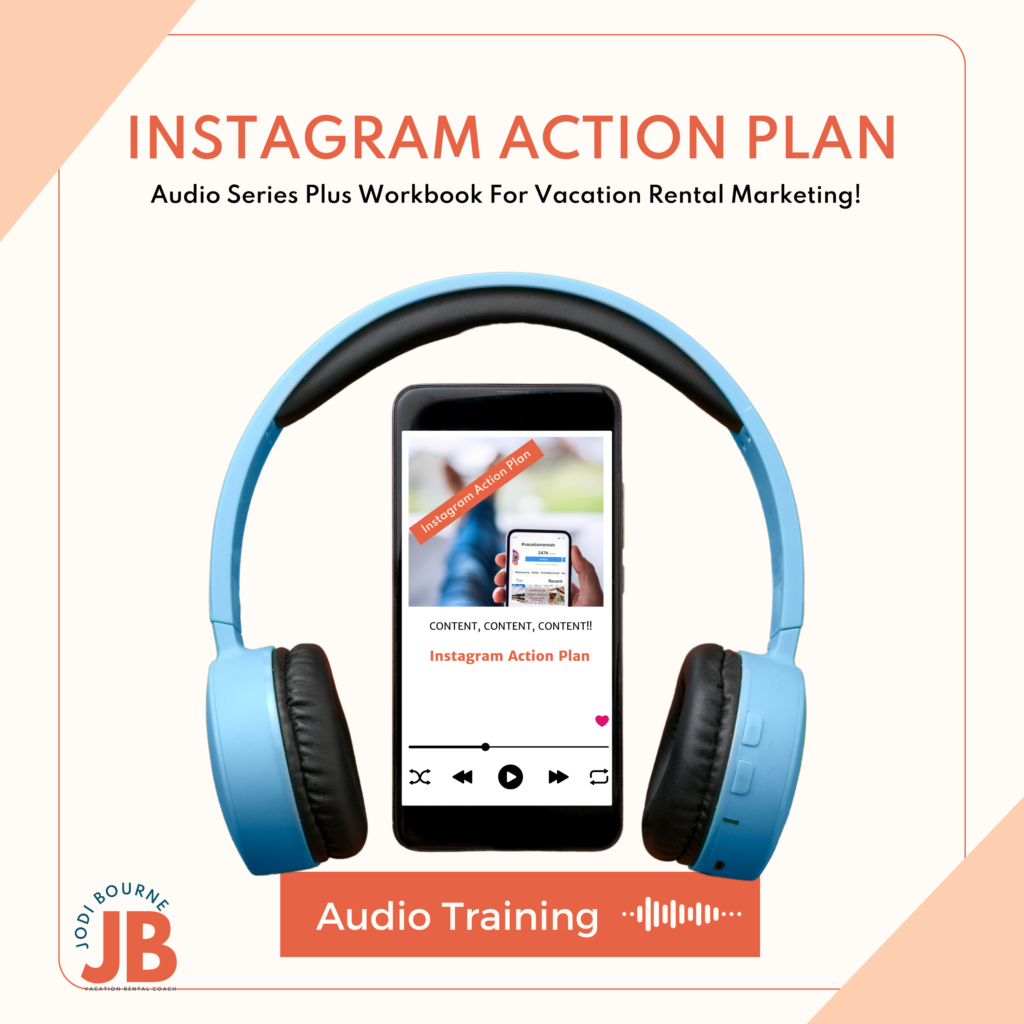Why Should You Start A Vacation Rental Blog?
If you are building a book direct marketing strategy for your vacation rental business, one of the first steps is to create a website.
Most owners stop there; they have a website with a booking engine and think that is all they need.
Many will never touch their website again. While others may attempt to add content on occasion such as local events, a list of area restaurants, or links to nearby things to do.
But, if you have a vacation rental website, there is much more you should do to drive traffic to your site – and that includes blogging for your target market and sharing your content everywhere you can. (This is called Content Marketing).
There is no doubt, blogging and content marketing is one of the best ways to make you stand out from your competition, grow a following and more importantly, increase daily traffic to your vacation rental website.
Even if you are a good writer and know all the things to share about your destination, it is still a pain in the butt to write, edit, and add weekly content to your vacation rental blog.
If you are not creating quality, easy-to-read content, that helps people learn about your destination you are hurting the overall success of your vacatin rental website and your direct booking goals.
There is a right way and a wrong way to create a successful vacation rental blog. Use these tips to see an improvement in traffic to your site over time and you should see an increase in direct bookings. (Use Google’s Search Console Tool to keep track.)
Tip #1: Write For Your Target Markets
Who will read your blog? Think about it. That is a super important question to answer before you even begin (or begin again).
Your blog, just like every other piece of content you create (images, videos, listing descriptions, emails), should target the people who will book your home.
If your mountain cabin is popular with young hiking and biking enthusiasts, why are you wasting time writing an article about family-friendly activities nearby?
Just because this is a subject you know about, doesn’t mean your specific audience cares about it.
You should know your “perfect guests” (the people who will enjoy your vacation rental the most) and create content that attracts and excites them.
Check out my FREE “Perfect Guest Avatar Workbook” to learn exactly who should be targeted with your content marketing – including blog posts!
Tip #2: Write For People Who Are Looking For Travel Ideas
Target Readers In The Planning Stage Of The Travel Journey
Your goal is to reach a new group of people, entice them with your content, bring them to your website, and get them dreaming about your vacation experience.
And you do that by creating content that interests people who are planning a trip.
One of my clients was super excited about a blog post she had written listing her top ten favorite restaurants in her destination and, by all accounts, it was a great post full of images, content, links, etc.
But, when looking at her Google Analytics, almost 98% of her readers left the site after reading her post.
Why? Because most people looking for restaurants in an area are already in that area. Her Google Analytics showed that as well – most of the people who saw this particular post were already in her destination (not the people who will book her home).
Later, she wrote a post about yearly flea markets and antique shows in the 40-mile range of her cottage. She made sure to include a description of her property and the large garage/barn she has for the safe keeping of large items. She mentioned some of the antiques in her home that she purchased from different vendors, which was a natural segway into sharing a link back to her availability search page.
Although she doesn’t get nearly as much traffic to this article, it was written with her target market in mind (women who loved flea markets, antiques, and decorating). More than half of her traffic to this page also looked at other pages of her site, including the property pages. The last time I checked her analytics, the availability search feature on this particular page was being used at least 2-3 times per month. That’s pretty impressive!
She knows from her inquiries about the barn storage for antiques that they found her and are booking because of this article and the extra amenity she provides for this target market.
Tip #3: Think Like A Travel Influencer
Not everything should be/has to be about SEO value. In fact, much of your content will never be seen if you solely rely on SEO. So, you have to also include articles about your destination that will appeal to your social media followers, current and previous guests, and others who may share your content.
People love to travel. They love to dream about travel, and they love to plan to travel. They read and follow blogs (and social media) that inspire their travel dreams. Travel blogs are one of the most read and followed types of blogs and much of that content is not found on Google Search, but by others sharing content with them.
However, travel bloggers and influencers don’t just list their favorite things to do in a city. They write about the experience of being in a destination. They share compelling content that makes people long for and dreams about a place. When writing about their vacation, many travel bloggers write about the vacation home, resort, or hotel they are staying in.
When you think like a travel blogger, your posts will be read, saved, and shared more often. Instead of writing about “Five Great Restaurants in Breckenridge” (boring, and only for those looking for restaurants in Breckenridge) try, “5 Fun & Romantic Date Night Ideas In Breckenridge.”
Just remember, your blog content needs to be entertaining, informative, and persuasive. Basically, all the things your 8th grade English teacher taught you about writing a theme paper.
Tip #4: Write Better Blog Titles
The goal of the title is to make readers stop and think, “This is so damn (interesting, unbelievable, crazy, informative, etc.) I have to know more.”
Seriously, your article’s title has to be compelling enough to make the reader stop, read and share with all their friends and family (you know, all those would-be guests out there in Facebook land who are dying to go on vacation to someplace NEW!)
One way to make your headline compelling is to use more emotional words and power words.
Co-Schedule, a content marketing scheduling app, shares some great tips on why and how you should be using emotional words in your headlines.
Where does your title appear?
- In search engine page results, known as SERPS (when someone searches for the keyword or topic)
- At the top of your post on your website
- On archive pages and the home page of your site
- In social media posts when you or others share it
- Everywhere else it lives online
When you create headlines that are ultra-specific, useful, and speak directly to your target audience, you are on your way to winning the blogging game. (Bonus, your articles will be shared more when it has a fun, compelling headline.)
Instead of “Things To Do With Kids In Joshua Tree” could become, “Ten Tips For A Fun Family Vacation In Joshua Tree“
HINT —-> Lists and tip articles are super popular because your reader knows they will be easy to read and provide good information.
Tip #5: Write Longer Posts
Google knows if you have amazing content on your website.
How?
Your site visitors tell Google through their actions if your blog or website is useful, informative, or entertaining.
When your visitors spend time on your page – by reading your content, engaging with your page, clicking other links on your website, and sharing it with others, they are letting Google and Bing know “Hey, this is valuable, thanks for sharing!”
But, when you have just a couple of paragraphs, a simple list with no explanations, or a short video post, they don’t stay on your site as long, ultimately telling Google – this isn’t relevant; stop showing it.
BIG MISTAKE. If Google gets signals that your content isn’t valuable, they will stop showing it to searchers.
If you can’t create a post with valuable content that engages your visitors, don’t create one. Before you start writing new content, think of ways you can make the blogs you do have even better.
Tip #6: Share Your Blogs On Social Media (You Aren’t Marketing Your Blog)
Do you know who I count on every month to read my blog posts?
My mom. My husband. Sometimes one of my three kids.
Actually, I don’t even think my mom reads them (we will know if she says anything about this comment).
Other than that, I cannot count on anyone. So, I share it everywhere.
I share it on my business Facebook page. I share it in my Facebook Vacation Rental Marketing Group. I mention it on Instagram. I share it in my email newsletter.
When I write a blog post for a client, we share it everywhere and we share it more than once. That’s part of a content marketing strategy that is vital to the success of your book direct mission.
You should be sharing your articles on Pinterest, Instagram (with an image and link in your profile), Twitter, Facebook Community Groups, emails to former guests, and anywhere else you can think of. This is vacation rental marketing 101!
Also, be sure and use sharing tools and icons on your website to encourage your readers to share as well. If you look below this post you can share it quickly and easily. THANKS in advance!
Remember, Google is kinda sorta keeping up with how much love your blog posts get. So give your post some love yourself! Be proud of that bad boy!
HOT TIP —> Add Social Media Share Buttons at the bottom of each post to encourage sharing! (see mine at the bottom of this.)
Tip #7: Stick To A Content Plan
The quickest way to lose is to not plan how to win!
^^^^ I just made that up! ^^^^
It’s really the truth. Most blogs die out in less than a year. Many never really get started enough to enjoy the sweet, sweet taste of success and that’s a shame.
Blogging about something you are passionate about and getting readers, followers, and comments – that’s super cool. Buy yourself a beer!
But blogging about something you are passionate about (your business) and making money (bookings!!) … oh, hell yeah! That ROCKS! Buy yourself a massage!
The biggest key to blogging success is writing consistent, quality content that creates interest in your destination and shows how your vacation rental fits into the perfect vacation plan..and to do that you need a content strategy.
Steps To Creating A Vacation Rental Blog Post
- Use keyword tools to find relevant topics. (more on that below.)
- Choose 4-6 topics you can write about over the next month. (at first, plan to devote 3-4 hours for each post, but it gets easier.)
- Do a quick Google search and read a few posts that others have written on the topic you’ve chosen. Take some notes about how you can expand on the topic.
- Write a quick outline of what you want to cover. In your notes, be sure and add links to any businesses or websites you want to mention. (this helps with SEO)
- Write your post in a Word Document or Google Doc or in a notebook if you prefer (don’t write your post on your website because you could easily forget to save it, etc.)
- Add your post to your website but don’t publish it until you have two or three ready to go and a plan for what to write next.
- Make sure you have used as many of the strategies I’ve outlined as possible. If you aren’t ready for the tech part yet, don’t worry. The first step is to get your content up and a habit started.
- Once your post is written and published, share it on social media and to your email list. Ask your friends and followers to share it too.
Sound like a lot of work? It can definitely be a ton of work. In fact, it is often so much work I don’t have time for it, but, I try like crazy to follow my plan as much as possible.
I know it is hard. I know it is time-consuming. It may even be boring.
If you use the steps and strategies I’ve outlined you will start to see success. The more you post, the more traffic you get. The more traffic you get (the right traffic, because you are targeting people interested) the more bookings happen (as long as your site is set up to convert blog readers.)
One tool I use to help make the ideas flow, especially when I am writing content for a vacation rental client in a new area is “Answer the Public.”
This keyword tool is so useful not only for helping you create a blogging plan but also to give you ideas for how to rephrase some of your content and answer multiple questions within one post in different ways.
Be warned, you can go down a huge rabbit hole with this tool, so be prepared to spend a bit of time there, or just bookmark the link today and add a reminder to check it out in your spare time. (Okay, most of us don’t have the luxury of spare time, so maybe make a 15-minute meeting with yourself next Saturday morning at 7 am to check it out.)
Tip #8: Optimize Your Blog For Search Engines (SEO)
SEO sounds like this big scary term to a lot of folks and it is easy to be intimidated by anything that says “optimization”, but look, you don’t have to be a tech genius to do this. There’s a ton of great SEO tools for WordPress (my favorite is Squirrly) Other platforms like Wix have their own tools as well.
You want your vacation rental blog content to be found when people search Google, Bing, and other search engines and one of the most important parts of that is “telling” the search engines what your post is about.
There are a few SEO steps you have to take on every blog post:
- Before you write, determine what keywords you should be using and then add them to your content in a natural way – use a tool such as Keywords Everywhere for this.
- Use heading tags (h1, h2, h3) within the content on titles and section titles. These headings keep your info organized but also gives clues to Google about your content.
- Add your keywords to meta descriptions – this is the little snippet of info Google shows people when they do a Google search.
- Add keywords to your image tags.
- Be sure and fill out the metadata description fields that include the keywords your article is about.
Remember, there are tools to help you do all of this.
Adding a vacation rental blog to your website may feel like a daunting task but it doesn’t have to be. With all the tips I’ve featured here, the most important is to create content that is interesting and that will inspire people to want to visit your destination.
There are people (including me) who can write these blog posts for you and even add them to your website. It is an investment you should consider if you have a few properties because, ultimately, if one blog post brings six bookings a year, it will be well worth it.
Want to learn more about Vacation Rental Blogging and other marketing strategies? Join the Book Direct Pros Mentorship!










